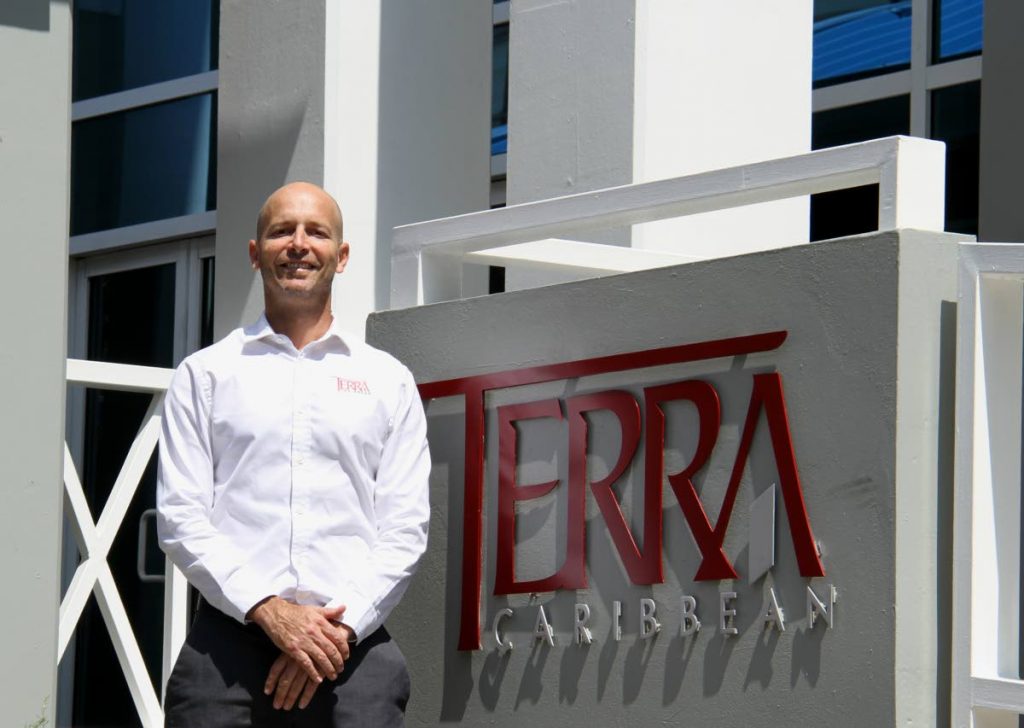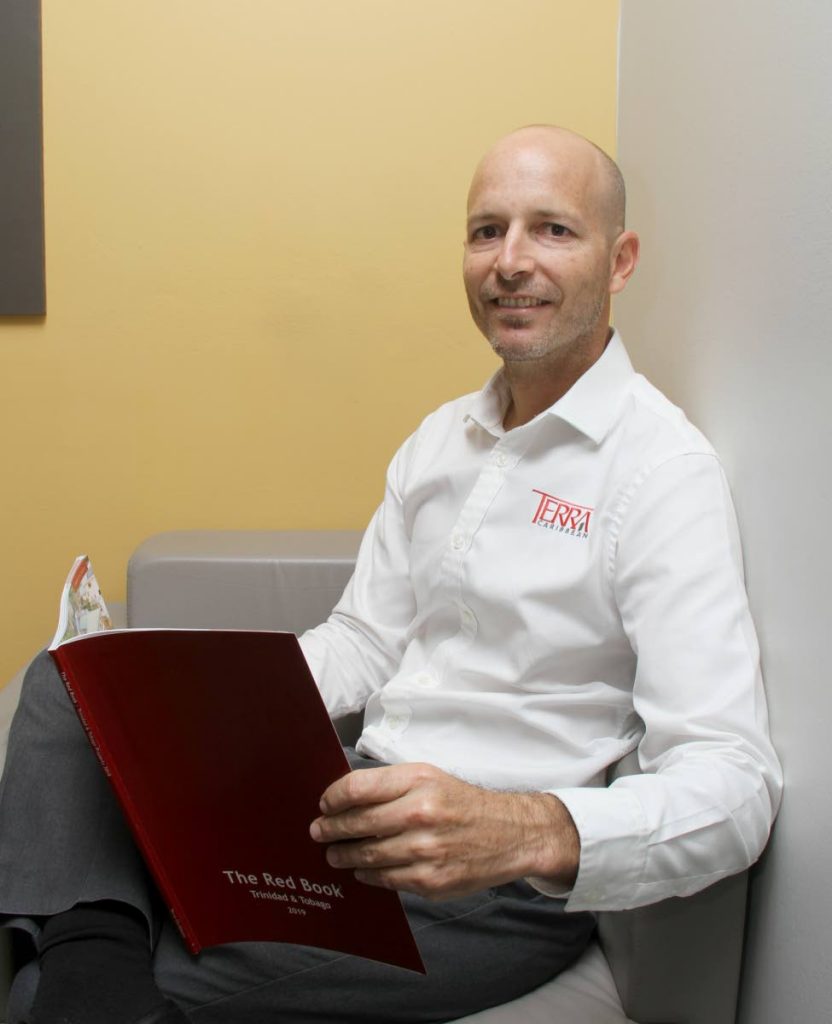Terra Caribbean maps out real estate deals

Terra Caribbean CEO Jean-Paul de Meillac believes now is a good time to invest in residential and commercial real estate in TT. Speaking with Business Day at the company's office in St Clair earlier this month, de Meillac said, "Over a ten-year period, real estate values go up. Why wouldn't they in a place like TT where there is a limited amount of land, limited amount of infrastructure?"
De Meillac added that traffic congestion, people's desire to live in certain areas, crime causing people to live in certain areas, high cost of materials and a labour pool that is not fantastic are other factors which contribute to a stable real estate industry in TT. But while the industry is stable as a whole, he said there are elements of it that have changed over time.
Having been involved in the industry for the last 20 years, de Meillac said Terra decided to publish its Red Book which serves as a comprehensive guide to real estate in TT. "We look at is as our contribution to the real estate industry." The book contains information collected over the last 20 years on different segments of the industry and offers insights into each one, he added.
Over the last 12 years, de Meillac said there has been a high interest by energy companies for commercial office space. But he said the reality today is there is quite a bit of vacant office space and not many energy companies are interested in occupying these spaces. "The downturn has affected commercial office buildings around TT as well as high-end residential property," de Meillac observed.
"We have observed commercial business moving out of Port of Spain," moving from downtown to uptown Port of Spain. He said in some cases, businesses have moved out of Port of Spain to places like Aranguez and Trincity where rent is cheaper.
On the residential side, de Meillac said, "Historically, Trinis have bought high-end houses in the west, Palmiste, south to rent to oil and gas executives." But with few or none of these people coming to TT now, he said, "People are not buying these properties to rent to ex pats."

He added the only people who will buy these houses are owner/occupiers or "people who are going to live in the houses." In situations where there is a smaller pool of buyers, prices must contract. "The high-end segment of the market has been hit very hard through the downturn."
De Meillac said the only people buying $5 million houses in Westmoorings right now are people who are going to live in them themselves. "There is a lot of stock on the shelves, so to speak, as it relates to higher-end residential rentals," which means there are quite a number of vacant spaces in apartment complexes like One Woodbrook Place, La Riveria and La Fontaine Towers. He said there are also a lot of unoccupied houses in Westmoorings and Goodwood Park, which is a "usual area for the ex-pats."
In its Red Book, Terra has identified a different type of buyer in the real estate market. These buyers are citizens who are looking for somewhere to live. "The average Trini cannot afford a $5 million Westmoorings house. So they want to buy $2 million and under," he said.
The downturn in the economy has seen developers densifying land. For example, he explained, a developer buys 15,000 square feet of land, and instead of turning it into three lots for three houses, six or seven town houses are built on it and offered at a lower price to potential buyers. Terra has seen that "new thinking individuals" who are seeking residential property "want to live in compounds where there is security, easier price point, pool and garden maintenance done by a maintenance company." In this scenario, de Meillac said, "We are doing more transactions in town houses and apartments as opposed to house and land."
He said there has been a move to places such as Chaguanas, Cunupia, Piarco and more central areas for residential property. "There's more development going on there, so you can afford to buy a piece of land there and build and sell houses there for the right price. That's where people are choosing to live."
Chaguanas for example, according to the Red Book, has expanded significantly over the last decade. It has a mix of retail and lower to middle income residential areas. Lange Park and Orchard Gardens are classified as upper-middle income areas. Cunupia is not as commercialised as Chaguanas. It offers quieter, large available land space for burgeoning residential neighbourhoods.
The D'Abadie/Piarco area offers residents access to the retail hub in Trincity and ample road networks. In addition to well-laid neighbourhoods like Signature Park and Darwill Gardens, the area also has many small town house developments located in several serene pockets.
On the value of property on the market, de Meillac said residential property is usually sold for above $5 million. Properties in the luxury real estate market, he observed, range upward from US$1 million. But, he noted, there is less interest in these properties at the moment. According to the Red Book, for the majority of luxury homeowners and investors in the fortunate position of not needing to sell, the market does not change their perception or price.
Neighbourhoods such as St Clair, Ellerslie Park, Bel Air and Valsayn are described as some areas "that fetch the big bucks and lure the affluent populace of TT." A common misconception, he said, is that a big house is a luxury house. He explained that luxury is not based on size alone and the development of a luxury home begins at the planning stage. Factors such as location, functionality and design determine whether or not a house is a luxury house.
But Terra is not only involved in high-end real estate. "We sell property right down to $3,000, $4,000 for a piece of land. We do residential rentals down to the price that the man in the street could afford," de Meillac said. "Landlords who usually got US$5,000 per month in rent are now settling for far less." Landlords are also settling for TT dollars because of supply and demand issues with foreign exchange.
He said many Trinidadians have purchased houses in Tobago to serve as vacation homes, but there is not a lot of interest by foreign nationals in doing so. He believes the reason for this was the implementation of a foreign-land-owning licence in the last five years, which has further restricted property sales in Tobago. Also, challenges with the domestic airbridge and seabridge have made it difficult for materials for home construction to be shipped there in a timely manner.
How different is the role of firms like Terra from that of the Housing Development Corporation (HDC)? De Meillac said, "The HDC does a good job in trying to create homes for people who can't afford them. They don't come to brokers like us to sell property for them." De Meillac said Terra is regulated by the Royal Institute of Chartered Surveyors and gets involved in real estate through valuations.
There is no doubt that TT's real estate landscape is changing. De Meillac said over the last 20 years the economy has seen many highs and lows which have affected the way firms like Terra do business. But he believes there remains tremendous potential for development in the industry.
This potential, De Meillac said, could only be developed with credible real estate information and Terra is committed to providing this to investors.

Comments
"Terra Caribbean maps out real estate deals"